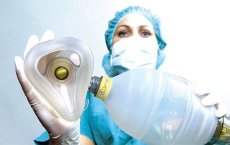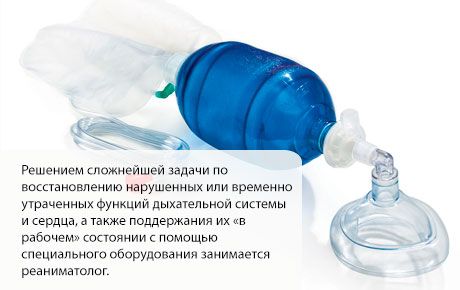New publications
Resuscitator
Last reviewed: 03.07.2025

All iLive content is medically reviewed or fact checked to ensure as much factual accuracy as possible.
We have strict sourcing guidelines and only link to reputable media sites, academic research institutions and, whenever possible, medically peer reviewed studies. Note that the numbers in parentheses ([1], [2], etc.) are clickable links to these studies.
If you feel that any of our content is inaccurate, out-of-date, or otherwise questionable, please select it and press Ctrl + Enter.

A resuscitator is responsible for solving the complex task of restoring impaired or temporarily lost functions of the respiratory system and heart, as well as maintaining them “in working order” with the help of special equipment.
Resuscitation is a branch of emergency medicine or critical care medicine. It deals with what other clinical specializations cannot do – emergency care when vital functions of the body are threatened, saving a person’s life itself, and, very often, practically reviving him in the event of clinical death.
Who is a resuscitator?
When breathing stops and the heart muscle stops contracting, the human body shows no outward signs of life, doctors state the first stage of the dying process - clinical death. This condition is reversible, since for several more minutes - despite the cessation of blood circulation and the cessation of oxygen supply - metabolic processes in the body continue.
It is in these few moments that a resuscitator takes on the task of saving the patient - a doctor who knows in detail how the human body functions and has studied all the terminal states of the body, that is, pathological functional changes that occur as a result of increasing hypoxia of the brain and all tissues, acidosis (pathological acid-base imbalance of the body) and intoxication.
When should you contact a resuscitation specialist?
Most often, cases when it is necessary to contact a resuscitator are associated with a state of shock, which is typical for many injuries and some diseases and has several varieties. Depending on the cause, shock can be traumatic, cardiogenic, hypovolemic (with large blood loss), infectious-toxic (with bacterial-viral lesions), septic (with sepsis and severe purulent inflammation), neurogenic (after spinal cord injury), anaphylactic (with allergies) or combined.
And a resuscitator will be able to provide the right assistance in case of cardiogenic shock in the case of myocardial infarction, and in case of pain shock accompanying the perforation of a stomach ulcer.
But, as resuscitators themselves note, traumatic shock is the most common case.
What tests should be taken when visiting a resuscitator?
Patients who are admitted to the hospital – to the intensive care unit – have their blood taken to determine their blood type and Rh factor, and have a general and biochemical blood test. Blood is also tested for coagulation (hemostasis), total protein, creatinine, urea, alkaline phosphatase, bilirubin, etc.

The tests that need to be taken when contacting a resuscitator depend on the specific disease or injury in which it is necessary to take measures against life-threatening pathological symptoms and conditions.
What diagnostic methods does a resuscitator use?
Resuscitators use various diagnostic methods, from laboratory tests of blood and urine, and electrocardiography, to ultrasound, computed tomography and MRI.
Monitoring of the main functional indicators – pulse, pressure, respiratory rate, temperature, acid and gas composition of the blood – is carried out around the clock, and resuscitators see the results of all measurements on monitors.
In addition, the patient can be connected to life-supporting resuscitation equipment (artificial lung ventilation apparatus, oxygen concentrator, pacemaker, drip system). All processes are also constantly monitored.
What does a resuscitator do?
You won't see a resuscitation doctor in your clinic, since his job is not to treat specific diseases. His job is to promptly identify and prevent such conditions of patients that cause a disruption of the most important functions of the body, which can lead to fatal consequences.
Working in the intensive care unit of a clinical hospital, a resuscitator knows what to do in such situations. The doctor begins to carry out all necessary resuscitation measures - using defibrillation shock (electric discharge to the heart area), medications, as well as using artificial heart and lung devices that provide assisted blood circulation and artificial ventilation of the lungs.
In addition, doctors of this specialization work in emergency medical teams.
A person's life depends on the professionalism of the resuscitator, on the promptness and correctness of his actions. Because without resuscitation, biological death occurs in three, maximum five to six minutes: the brain not only stops, but also irrevocably loses the ability to perform its functions, and all physiological processes in the cells and tissues of the body stop...
What diseases does a resuscitator treat?
There are many diseases, as well as their complications (primarily, conditions after surgery), which pose a high risk of death for patients and require certain resuscitation measures.
Resuscitators help people survive clinical death, as well as severe injuries that threaten life. These include injuries to the skull and brain, thermal and chemical burns (accompanied by pain shock), penetrating wounds, electric shock, pulmonary edema or water ingestion due to drowning, anaphylaxis (anaphylactic shock), severe intoxication (household and industrial poisoning).
What diseases does a resuscitator treat? The list of diseases that most often require the intervention of a resuscitator includes myocardial infarction and serious cases of cardiac arrhythmia; coma (diabetic, hypoglycemic, hepatic, etc.); embolism of various etiologies and arterial thrombosis; blood poisoning (sepsis), as well as some particularly dangerous infectious diseases such as tetanus, rabies, etc.
Advice from a resuscitation doctor
Sometimes it happens that a person needs urgent resuscitation assistance just on the street. The first thing to do - without delay - is to call an ambulance at 103.
If the victim does not move, check the pulse (on the carotid artery). If there is a pulse and independent breathing, the person should be laid on his side and wait for the ambulance to arrive, all the time monitoring the pulse.
If there is no pulse, then before the arrival of doctors it is necessary to carry out the basic life support measures accepted throughout the world - alternating artificial ventilation of the lungs (artificial respiration) and chest compression (indirect heart massage).
Advice from a resuscitation doctor on performing cardiopulmonary resuscitation:
- lay the victim on his back, straighten his head, lift his chin up, check his breathing again (but very quickly!) - pulse on the carotid artery, movement of the chest, noise when exhaling, color of the lips;
- kneel down at the side of the victim, open his mouth, pinch his nostrils with your thumb and index finger, bend over, take a normal breath and exhale air into the victim's mouth (repeat twice);
- the presence of the so-called "passive exhalation" will indicate the patency of the human airways.
Next, they begin to restore heart contraction by means of indirect massage:
- place the palms of both hands (one on top of the other, with the support on the base of the hand) in the center of the victim’s chest, with the arms straight at the elbows;
- apply rhythmic pressure to the victim's chest, strengthening it with the upper part of your body;
- the sternum should drop by 4 or 5 cm, after each press the chest must return to its original position;
- the number of starts is 30, then artificial respiration must be performed twice again.
If attempts to restore the heart's function using cardiopulmonary resuscitation techniques are unsuccessful (and if emergency medical assistance has not yet arrived), a precordial thump is used, the purpose of which is to "start" the non-beating heart with a strong concussion of the chest.
The striking technique is as follows:
- make sure that there is no pulse in the carotid artery;
- cover the xiphoid process of the sternum with two fingers;
- with the back of a tightly clenched fist (the elbow should be positioned along the victim’s chest) from a distance of 20-25 cm, deliver a sharp, short blow to the lower part of the sternum – above the fingers covering the xiphoid process;
- check the pulse again (on the carotid artery), and if it is absent, repeat the blow 1-2 times.
It should be remembered that in the presence of a pulse, a precordial blow is never applied. Resuscitators claim that in emergency situations, the first pre-hospital aid for clinical death (in particular, in case of electric shock) is a blow to the sternum, which is especially effective immediately after cardiac arrest.

 [
[